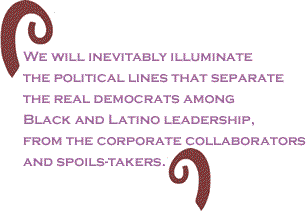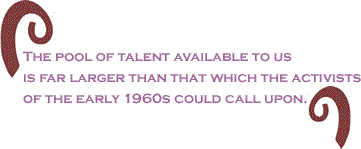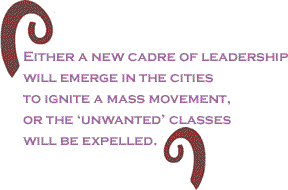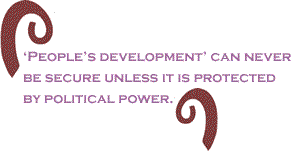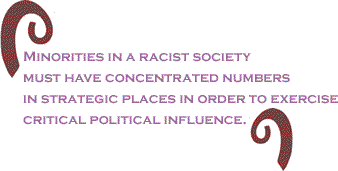
|
|||||||||||||||||||||
 |
We have arrived at an historic juncture in the racial-political-economic geography of the United States – and a critical moment in the African American saga. A convergence of circumstances has provided Blacks and their progressive allies a window of opportunity to seize the political initiative from the ruthless and profoundly racist dictatorship of corporate boardrooms. If we allow this window to close without taking decisive action, the evolving corporate “model” will crush or swallow every practical social mechanism of resistance. The fatal blow will come when the Black and Latino populations of America’s cities – the only potential mass base of opposition to corporate rule – are dispersed from the urban centers. It is here, in the geography of the cities, that the line of resistance to the rule of the rich must be drawn. Therefore, we must take the offensive now, while Blacks and Latinos still represent urban majorities, and while the corporate schemes to co-opt and, ultimately, displace these populations are still fragmented and uncoordinated. Time is of the essence, since corporations travel at the speed of money. But the key elements of resistance to the corporate “model” are already in place. There is much reason for optimism. Black America’s resources and effective allies are infinitely more abundant than they were two generations ago, when relatively small numbers of talented and committed activists transformed the national political landscape. They took on an apartheid nation and achieved many of their primary goals, despite the relative absence of super-concentrated Black population centers, in an environment in which African Americans were frozen out of entire sectors of social and professional life, and when half of Black America could not vote. These activists won because they had a Plan, and because they took the battle to the centers of Jim Crow power – with 10,000 anti-racist demonstrations in 1963, alone.
Objectively speaking, our chances for victory are much better, this time around. Our current enemy is made up of small groups of men in suits – men who are unpopular among most of the U.S. population, but who have Plans for the cities and the capital to back up their schemes. To defeat them, we must call forth and give shape and practicality to the aspirations of the current urban population: we must facilitate their dreams. In doing so, we will challenge the logic of capital – a logic that leads inexorably to the dispersal of existing non-white, urban populations – with the logic of Democratic Development, which demands a Plan that serves the needs of the inhabitants of the cities. Our political strength will spring from people’s inherent desire to shape their own surroundings, and from the general awareness among city dwellers – particularly African Americans – that they are targeted for removal. Our most tangible assets are the human and material resources of the U.S. labor movement, now finally aware that it is fighting for its very existence. To our great advantage, the cutting edge elements of our Movement for Democratic Development are already serving on the line, fighting rapacious “developers” – including the role “model” for U.S. corporate behavior, Wal-Mart. These innovative, community-based organizations work closely with the most progressive sections of labor – an alliance that has matured and blossomed in Living Wage campaigns and in common resistance to Wal-Mart’s relentless outrages against the rights of workers and communities.
At the core of the movement that we will create, is Black labor, the critical interface between the labor bureaucracy, progressive grassroots activists, and established African American institutions. At least until recently, one of every five Blacks were part of union households. African Americans are disproportionately represented in the devastated manufacturing sector; in those service industries, such as retail foods, most directly affected by urban “development” schemes; and in the public sector – the whipping boy of corporate power. They know who the enemy is, and are not dazzled, as are so many Black institutions, by the trappings of corporate wealth. Most importantly, the bulk of Black labor lives in the cities, or are intimately connected to the urban center. The new Movement for Democratic Development is conceived as much more than just another attempt to put breaks on the excesses of corporate power. It must be a movement that fights for real democracy in urban America – the kind of democracy that gives the people of the cities the right to determine who builds what, where, and for whose benefit. Our mission is to provide the resources and specialized expertise that will allow the people of the cities to create their own roadmap to development, with the full understanding that corporations are intent on shaping cities that serve only themselves. Black labor – men and women who are consciously Black, militantly labor, and overwhelmingly city dwellers – must play the central role in the new movement.
Black labor has another special responsibility: to transform union pension funds into resources of capital for wise investment in the cities, jurisdictions whose ever-increasing value must be preserved for the people who live there. Black city dwellers are the people on whom unions depend, politically, in their struggle to survive the current corporate offensive in America. If this population base is dispersed, organized labor will be crushed, as well. Black labor understands this, and must take the lead in creating new investment strategies based on rational, Democratic Development – investments that serve both the pensioner and his/her political base. It won’t cost much money to launch and sustain this new Movement for Democratic Development. The most efficient elements of the civil rights movement, such as the bare-bones Student Non-Violent Coordinating Committee (SNCC), didn’t require tens of millions of dollars to shake the nation. That’s because they struck at the heart of the enemy, armed with a Plan that tapped directly into the fountain of Black people’s dreams. Take the initiative We must disrupt and supersede corporate development schemes, by becoming city planners in the service of the people. We must take the initiative away from the corporations, who are currently in possession of all the data that make up the life of a city, and who use it selectively to present their self-serving brand of “development” as the only option available. We must redefine the term “development,” to mean change that benefits the people impacted by the project. Development that does not meet that definition, is unacceptable.
We must halt the corporate-imposed triaging of urban America, that accepts the incremental expulsion of populations based on corporate promises of a “greater good” in the future – for those who somehow manage to hang on to their addresses. We must act in the confidence that a “sellers market” exists in urban America, one in which the people of the cities can strike the best deal, if they know the true facts. We must redraw the routes of urban commerce and employment, and demand that investors seeking entrance to a rational economic setting conform to the principles of Democratic Development. Relatively small teams of people, equipped with specialized knowledge of how cities function, and having gathered the widest possible specific information on targeted cities, can provide the basic outlines for comprehensive urban Plans that serve the inhabitants. These Plans, created in a process that intimately involves the people themselves – eliciting their dreams – will serve as the basis for democratic discussion, negotiations, and struggle over the development of the city.
New leadership will emerge, just as occurred in the Sixties. Indeed, authentic leadership can only emerge in the context of struggle. We will proceed in the knowledge that, in general, the long period of capital disinvestment of U.S. cities has ended. Gentrification of inner cities – once a “creeping” phenomenon, now in full swing – is just one manifestation of capital’s collective decision to return to the cities, and reshape them to its own purposes. In a capitalist market economy, this means cities have become more valuable. In a perverse but very real sense, corporate designs on the cities can serve to empower the existing Black and Latino populations – but only if it can be demonstrated to city dwellers, in the greatest detail, that they 1) occupy spaces of great value, 2) have the right to determine how these spaces are used, and, 3) are competent to devise alternative Plans for the development of the entire jurisdiction for the betterment of their families and neighbors: to build the city of their dreams. No activist worth her salt can doubt that people will fight for their own dreams, once they become aware that these dreams are possible. If we develop a process and practice that addresses the three items listed above, we will have launched a new movement, one that is replicable in cities across the nation – and will change the political complexion of urban America. We must assemble and field a Team that will tackle the three foundational items. The Audit The Team’s first job is to perform an Audit of the targeted city’s comprehensive assets. This task directly addresses item 1), by clarifying in great detail the value of the city.
Most city dwellers already know that they face displacement because other people have uses for the spaces in which they live, or that outside forces are creating conditions that undermine their ability to remain in their homes. However, this general understanding – that they are not secure in their space– most often leads to fatalism and malaise, rather than action. Our mission is to show in the greatest possible detail where each neighborhood fits – or has been made not to fit – in the existing patterns of city life. This requires an Audit of the entire city. We must present the fullest picture of the city’s demographic, physical, and economic layout and activity: where different populations live; how dollars move; where people work, and what types of work they do; where they shop; how they move around the city; what public or private institutions anchor which neighborhoods, and what activity do they create; what is the state of the housing stock, and where; how many businesses exist; who owns them, and who do they employ, and where do the employees live; what is the state of infrastructure (streets, water, sewage, phone and cable telecommunications, mass transit lines, etc.), and who does the infrastructure serve; what are the physically attractive (and, therefore, valuable) sites and vistas, and who owns/controls them; how are police deployed; where are the schools; what is the general pattern and history of growth and decline, and why? Corporations routinely demand much of this type of data from local governments before investing in a city, and augment the public record with their own research. They gather information useful to their profit-making mission, to further their enterprise and protect their investment. (They then proceed to distort the data, to create the impression that the corporate project is not only the best course for the city to follow, but the only reasonable option available.) We must assemble an even wider range of data, because our mission is larger: to empower the population to recognize, seize control of, and deploy their collective municipal assets to enhance their own lives. We must give them the data and tools to both protect them from corporate power and allow them to engage in fair and productive negotiations with investors of good will. We must make it possible for the people to see the city as it actually exists, so that they can rationally dream, plan and build the city as it should be. According to their Plan. In order to strategically describe the real city, the Movement for Democratic Development’s Team must conduct an Audit that takes note of every significant public, quasi-public, and private asset (property and enterprises of all kinds) within the city boundaries. It must also do as thorough as possible an assessment of the revenue sources of the city – often a very difficult job, in the murky and corrupt world of tax abatements and other subsidies and giveaways. Fortunately, progressive activists are already honing these specialized, investigative skills. The Audit will allow local residents – old activists and brand new ones – to see their own place in the scheme of the city. This is transformative in itself, but is only part of the utility of the Audit. The primary purpose of the Audit is to reveal to the Team and local residents the actual nature, value, and potential of the city – so that they know precisely the assets that are available to those who exercise political control over the jurisdiction. What we will create at the end of this stage of the process, is a cadre of city planner-activists: local leaders with a clear vision of their surroundings, and a burning desire to put the people’s dreams to work, by every means possible. But first, after completion of the Audit, it is the Team’s job to create and present a general framework in which Democratic Development can rationally occur in the city, based on the totality of the data collected – and presupposing the use of municipal powers of eminent domain, the tool used so routinely in the service of corporations. The Team
The Team will be guided in its macro-planning work by the principles
that we outlined in the first edition of
The Team will examine the city’s existing patterns of life, work and commerce, and dare to propose ways that the infrastructure and assets might be rearranged to maximize their value to the existing population of the city, and to businesspersons of good will, as well. There is nothing novel in this approach. City’s have remade themselves many times over – nearly always at the behest of corporations. Moreover, it is absolutely necessary that the infrastructural biases that exist in all cities be reexamined and corrected, since they represent layers of deliberate discrimination, piled one on the other over generations of rule by the rich and privileged. To the extent that the sordid legacy can be made more rational – that neighborhoods purposely isolated can be connected to the mainstreams of city life, and that corridors of commerce become arteries that sustain the city as whole – it should and must be done.
What is certain is that the cities were not made for the benefit of Blacks and Latinos, and have been made even more inhospitable and irrational since our arrival in large numbers – or, in the case of the South and the Southwest, since Blacks and Latinos stood up and acted like people with rights. Corrective action is long overdue. Corporations and their political allies believe that what’s wrong with the cities, is the people who live in them. We, on the other hand, believe there’s nothing wrong with the cities that the people can’t fix. The Team will present to local residents a number of broad Democratic Development scenarios that are within the realm of the possible, as revealed by the Audit’s comprehensive data. We must emphasize that we are seeking rational ways to reorganize the city’s assets for the benefit of the current population, including the creation of enhanced, rational and socially healthy investment opportunities. Therefore, the Team’s task is to devise general schemes for the city as a whole, treating the municipality as an organism that needs doctoring. This will provide a citywide framework for local residents to “dream” their own neighborhoods’ in the context of new configurations of assets and connections – to remake their surroundings in solidarity with other neighborhoods that are also seeking a new beginning, and to fully participate in the municipal community. The presentation of the Team’s Audit and resulting macro-planning scenarios will answer the question inherent in item 3), i.e., whether local activists and their allies “are competent to devise alternative Plans for development of the entire jurisdiction for the betterment of their families and neighbors.” In the course of the presentations, and in great detail, Team members will also explain precisely why the residents of cities “have the right to determine how these spaces are used” – the subject of item 2) – a discussion of legalities that leads directly to the necessity of action to seize political power. A huge pool of talent Which brings us to the composition of the Team. Clearly, there must be members with experience in the complexities of such arcane legal areas as eminent domain, etc. But this is essentially a political project of mass mobilization and social transformation. The Team must be competent to perform the technical aspects of the Audit, and to develop several macro-Plans for each New City, while guided by progressive principles and zeal. Its mission is to dissect the innards of the targeted city, present rational alternates to the existing, corporate-driven patterns of “development,” and explain how various neighborhoods can achieve their own developmental goals through coordinated political action. This will require a host of disciplines and experiences.
In addition to the obvious legal component, the Team must include progressives with expertise in city planning, social demography, political economy, small business development, corporate planning, civil engineering, police science – progressives experienced in the broadest range of urban development fields. At the heart of the Team, however, are the Organizers – who may also be expert in specialized fields. The Organizer’s job is to make it clear at every stage of the Team’s engagement with local residents that their dreams can be realized, but only through political action. We will also have great need of architects and artists who can render the look and feel of the people’s voiced aspirations – who can make their dreams “real,” tangible, and ultimately, a cause for action. That’s what corporations do, when marketing their greedy dreams of conquest. They design and render waterfronts and skylines that have no connection with our communities, because they will replace our communities. This is a form of propaganda that we are fully equipped to not only counter, but to outclass – in the service of the people’s vision that we will elicit in the course of this project. At the beginning of this article, we noted that “Black America’s resources and effective allies are infinitely more abundant than they were two generations ago.” The pool of talent available to us is far larger than that which the activists of the early 1960s could call upon. And the needs of our project – a Movement for Democratic Development, an offensive against corporate rule of the cities – are quite different. The SNCC-led “Freedom Summer” of 1964 is a useful reference point, as we compare the relative difficulties that we face in creating a new movement – after three-plus decades of no movement at all. A pretty good website describes the launching of Freedom Summer, this way:
We need no more than 20 very good people (the Team) to ignite an organized, mass rebellion of the soon-to-be dispossessed in America’s urban centers. The majority of the Team will not be white. All of them will have amassed a wealth of experience in their respective fields of expertise. They will be backed up by sections of organized labor and a host of activist organizations intimately involved with the problems they will face in the field. And, none of them will die. We can do this. Black Labor
We have assumed that sections of organized labor will back this project, because this is where the corporate offensive – exemplified by the Wal-Mart “model” – has taken them, and all of us. There is no choice but to confront the “model,” which means we must challenge the legitimacy of corporate rule by agitating in the ranks of those who are most immediately and aggressively impacted: Blacks and Latinos in the coveted urban centers. The terminal crisis looms. Either a new cadre of leadership will emerge in the cities to ignite a mass movement, or the “unwanted” classes will be expelled – to become politically neutralized by dispersal. The grand dreams of (most) Black folks and Big Labor will become…baseless. Labor is already deeply engaged in the new battlefield that corporations have created, an arena that Black labor, which is inseparable from the Black masses, eagerly enters. Our mission is to alter the configuration of the field, by taking the initiative, through a Movement for Democratic Development. Among the most active elements of labor, there is no question that such an initiative is necessary. However, there is more that must be asked of the unions. It is the same question that is asked by the unemployed, the prison-stigmatized males, and the child-burdened female youth of the ghettos that are targeted for the kind of “development” that even the least-schooled of them knows means eventual “removal.” Their question is: if not this kind of development, What?
Labor’s answer lies in the pension funds, which have historically been pools of working people’s capital (deferred wages) served up to the uses of capitalists. The capital that built Las Vegas for mobsters, and that even now builds luxury apartments in mid-town Manhattan. No one expects that labor pension funds will finance ghetto revitalization – the needs are too vast. However, it is necessary that labor plant dramatic flags in the areas that the Movement for Democratic Development enters, by making significant investments in projects that are called forth by the voices and Plans of the people, elicited by the Teams of the Movement. Such investments will be much more than symbolic. They will create “facts on the ground,” fiduciary responsibilities of labor pension fund trustees and executives, that must be defended against the encroachment of rapacious corporations, such as Wal-Mart. In the final analysis, “people’s development” can never be secure unless it is protected by political power. There is no escaping the necessity of labor finally casting its lot with its most dependable political base, and financing the candidacies that must result from the Movement for Democratic Development’s agitation and “dream-making.” Labor must do more than just pay for the calling forth of dreams. It must also help bring those dreams to fruition. It must be prepared to field and finance a righteous line of candidates to take power in the cities targeted by the Movement for Democratic Development, in order to defend its political and (hopefully) economic investment in the New, non-corporate Order. This is a project for political power in the cities – the power to control and protect valuable urban property, so that we can make dreams come true for the occupants of that property. The political project
We are keenly aware of the very good work that is being done by activists who seek amelioration of the problems of the central cities through regional collaboration among jurisdictions – i.e., their efforts to demonstrate that both city and suburb suffer from the irrationality of corporate development. We, however, believe that the irrationality of racism – the historical enabling force in the creation of suburbs – encourages the socially irresponsible behavior of corporations. The two are intertwined. Nevertheless, as the contradictions of both corporate “development” and its offspring, suburban sprawl, multiply, there is great potential for meaningful collaboration among nearby neighbors. Especially as the inner “suburbs” become replicas of the inner city – heavily Black and increasingly Latino. We are, however, on another mission. We are attempting to create a popular movement in a nation that has had none for 30 years. Our intention is to preserve and further empower the huge and strategic Black and Brown presence in the central cities. Minorities in a racist society must have concentrated numbers in strategic places in order to exercise critical political influence. It is an awesome truth, scrawled in shameful history, that there is no dependable progressive base in the U.S. except for Black America, which is called upon to hold high the principles of civilization in the face of constant assault by white people suffering from what is far too clinically described as “false consciousness.” Black people must stay together in sufficient critical mass to preserve ourselves, and as a by-product, we just might preserve the nation. Latinos can and must speak for themselves, but we at We will close with special attention to those concerned with the fate of Black business under a Plan for Democratic Development. It must first be said that there is no hope for anybody’s independent business survival in a corporate-ruled marketplace. Black business, small business, will find its only protection under the umbrella of people’s political power, the only defense against the corporate regime. Black people want Black business to exist. We will find ways to protect it – in our Plan. We must take the initiative against corporate power. Now. Click
here to read Part 1 of this series. Click
here to read Part 2 of this series. |
July
29 2004 |
|||||||||
|
|||||||||
|
|
|||||||||
| Printer Friendly Version | |||||||||
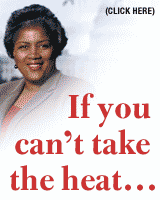 |
|||||||||
| |
|||||||||
| |
|||||||||

























